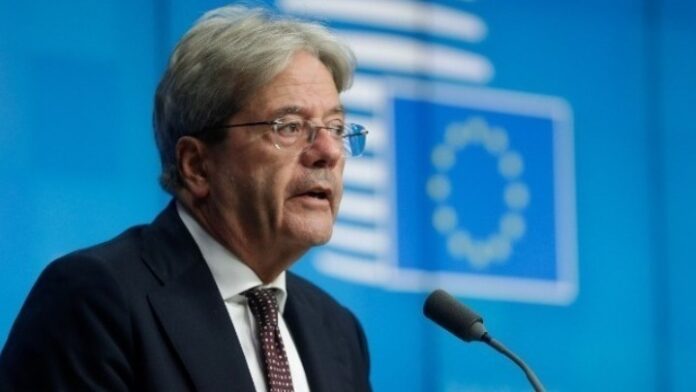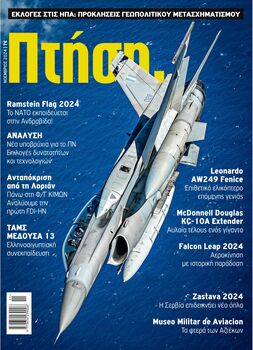After the Recovery Fund (NextGenerationEU) expires in 2026, the EU needs a new financial instrument of joint borrowing that will respond to the new common European objectives, such as defense, cutting-edge technologies, and clean technology, EU Commissioner for Economy Paolo Gentiloni said in an interview with the Athens-Macedonian News Agency (ANA-MPA) and three other EU media in Brussels.
A few days before the European Commission presented its interim report on the implementation of the member states’ recovery and resilience plans, Gentiloni noted: “We are halfway there.”
He pointed out that the majority of the investments come in the last three years and expressed his satisfaction that the recovery plans have already managed to reduce the growth gap between member states. Regarding the new fiscal rules, the Italian Commissioner underlined that if they are approved, their implementation will start in 2025, which means that in the autumn the member-states will have to submit their multiannual adjustment plans.
Asked what the new challenge for Greece is, he replied: “Greece is one of the countries with high growth rates, which is not a coincidence if one considers its course and the difficult situation 10 years ago. After the pandemic, there came a fairly strong growth that continues until the limit of our economic forecasts, in 2025.
“Now Greece, like all member-states, has to implement the difficult, second half of the recovery and resilience plan, during which most of the investments are made. The level of implementation of the Greek recovery and resilience plan, so far, is good. The third payment was disbursed at the end of December. Also, last year, especially after the fires, the Commission worked hard to redirect part of the funds to deal with the climate crisis. After this reorientation of funds, a quick and smooth development in the implementation of the Greek recovery plan is expected.”
The interview follows:
In its winter economic forecast, the European Commission sees the Greek economy growing at one of the fastest rates in Europe. What is the new challenge for Greece?
Greece is one of the countries with high growth rates, which is not a coincidence, if one considers its course and the difficult situation 10 years ago. After the pandemic, there came a fairly strong growth from 2021 to our forecast horizon which is 2025.
Now Greece, like all member-states, has to implement the difficult part, the second half of the recovery and resilience plan, during which most of the investments are made. The level of implementation of the Greek recovery and resilience plan, so far, is good. The third payment was disbursed at the end of December. Also, last year, especially after the fires, the Commission worked hard to redirect part of the funds to deal with the climate crisis. After this reorientation of funds, a swift and smooth development in the implementation of the Greek recovery plan is expected.”
Next week the Commission will present the midterm report on the implementation of the recovery and resilience plans of the Next Generation EU. What are your conclusions?
We are about halfway there. The big challenge is the effort that must be made to implement the programs in the next two and a half years, so by June 2026. We have already spent about 224 billion euros and the large bulk of the investments must be made in the last three years.
Note that in the first three years, efforts in many member states had to be focused on reforms. Also in 2023 a redesign of the plans was to be done to add the chapters of REPowerEU. But the bulk of the investment comes in the last three years. And this is a reason for both concern and optimism. So the effort to be made in the second part and the remaining 2.5 years is very important. The success of NextGenerationEU (NGEU) is crucial to be able to discuss the further steps and further tools at EU level.
The NGEU was essentially designed for two reasons: for solidarity (amid the COVID pandemic this common financing was decided) but at the same time, it was designed to avoid the risk of what we call “ fragmentation”, so the divergence among member states. And honestly, from this point of view, we can already say that the recovery plans must limit the divergence in growth between the member states. The countries that receive the largest amount of funding through the RRF as a percentage of their GDP are the countries with the lowest level of development. In my opinion, this is not by accident. The release of these funds also sent a positive message to the financial markets.
Can the NGEU be extended beyond 2026, as some countries have requested?
There is a deadline. Legally, part of the decision taken at the time cannot be extended. Especially as regards the decision to raise common money from the financial markets, this has a clear deadline. To change this deadline must be approved by 27 or 29 national parliaments. So honestly, I would not spend a lot of political capital on this, but I fully share the view that after the implementation of the NGEU we need to discuss as soon as possible – before 1 January 2027 – what comes next.
A new financial instrument of joint financing, therefore?
This will be discussed in the next legislative cycle. It is clear that we have some common European goals and this would deserve at least partially common financing. Yes, you can mention defense or cutting-edge technologies, clean technology. You know that President Ursula von der Leyen proposed something similar a year ago, when she referred to a European sovereign fund, which today is limited and is the STEP program, but it could be a first step.
This is a strategic discussion, and it is correct that will be addressed by the new political cycle of the Commission, Parliament, and Council. Strategically, economically, and politically, the method we used for the NGEU cannot be a parenthesis. Because otherwise we will either completely change our state aid rules mechanisms or run out of tools for common programs. So the issue of what is next after the NGEU is crucial and I think the discussion should start already next year. The global race for clean technology continues and this cannot be tackled by each member state on its own.
A week ago, EU member states and the European Parliament reached an agreement on the reform of the EU’s fiscal rules. When will the new rules be applied and what are the next steps?
The process, I think, is very clear. The new rules will have to be approved by a final vote by the European Parliament probably in mid-April and the following day by the Council (Coreper). After that, we will confirm with member states the implementation of the new rules already in 2025. My impression is that the majority of Member States agree to start implementing the new rules as early as 2025, with four- or seven-year plans. This means that the period of summer and autumn of this year will be very hot with the negotiations between the Member States and the Commission on the multiannual plans. It has not been decided when the Member States will have to submit their multiannual plans, because the rules have not yet entered into force, but presumably in the autumn (September-November), after the summer break, we will receive the plans.
Regarding the 50 billion euros planned by the EU for Ukraine over the next four years, do we perhaps have a clear picture of how these funds are going to be handled in a transparent and accountable way by the Ukrainian authorities?
Yes, definitely yes. You know that this is built on the experience of the methodology we use for our macro-financial Assistance programs. It is not the same, but it is based on this experience, which means that we have with the Ukrainian authorities Memorandums that we share and in these memoranda, there are targets that the Ukrainian authorities are committed to reaching, and most of them are, of course also related to the mechanism of public procurement of how the economy works of anticorruption mechanisms.
I have to say that this is already the experience that we had in the last two years. Ukraine delivered in the different steps that were in these memoranda. Of course, now we will have to bring forward a little bit in parallel with another part of the story which I think is politically very important for Ukraine, which is the start of the accession negotiations. Part of this process is, of course, also very demanding for candidate countries, including Ukraine. On reforms, rules, etc. So I think we should be very clear, and this was also my effort recently during my visit in Washington. Because of course, we are supporting solidarity, for our own interests and values, but we are asking very concrete steps to Ukrainians. And honestly, they are very efficient in delivering and this was also I think the basis for the, not obvious, IMF program. It Was not mechanical that the IMF would have decided on a program to support Ukraine. It was a very good decision. But of course, as always in the IMF, they also have their conditionalities. So Ukraine had to address both the conditionalities coming from the EU and the IMF and hopefully also from the US. We’ll see, because the process in the US is still open, as you know.










